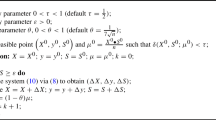Abstract
As in many primal—dual interior-point algorithms, a primal—dual infeasible-interior-point algorithm chooses a new point along the Newton direction towards a point on the central trajectory, but it does not confine the iterates within the feasible region. This paper proposes a step length rule with which the algorithm takes large distinct step lengths in the primal and dual spaces and enjoys the global convergence.
Similar content being viewed by others
References
T.J. Carpenter, I.J. Lustig, J. Mulvey and D.F. Shanno, “Higher order predictor-corrector interior point methods with applications to quadratic objectives,” to appear in:SIAM Journal on Optimization.
I.C. Choi, C.L. Monma and D.F. Shanno, “Further development of a primal—dual interior point method,”ORSA Journal on Computing 2 (1990) 304–311.
A.V. Fiacco and G.P. McCormick,Nonlinear Programming: Sequential Unconstrained Minimization Technique (Wiley, New York, 1968).
M. Kojima, N. Megiddo and S. Mizuno, “A general framework of continuation methods for complementarity problems,” to appear in:Mathematics of Operations Research.
M. Kojima, N. Megiddo and T. Noma, “Homotopy continuation methods for non-linear complementarity problems,”Mathematic of Operations Research 16 (1991) 754–774.
M. Kojima, N. Megiddo, T. Noma and A. Yoshise,A Unified Approach to Interior Point Algorithms for Linear Complementarity Problems, Lecture Notes in Computer Science No. 538 (Springer, New York, 1991).
M. Kojima, S. Mizuno and A. Yoshise, “A primal—dual interior point algorithm for linear programming,” in: N. Megiddo, ed.,Progress in Mathematical Programming, Interior-Point and Related Methods (Springer, New York, 1989) pp. 29–47.
M. Kojima, S. Mizuno and A. Yoshise, “A polynomial-time algorithm for a class of linear complementarity problems,”Mathematical Programming 44 (1989) 1–26.
M. Kojima, S. Mizuno and A. Yoshise, “A little theorem of the big ℳ in interior point algorithms,”Mathematical Programming 59 (1993) 361–375.
K.O. Kortanek, F. Potra and Y. Ye, “On some efficient interior point methods for nonlinear convex programming,”Linear Algebra and Its Applications 152 (1991) 169–189.
I.J. Lustig, “A generic primal—dual interior point algorithm,” Technical Report SOR 88-3, Program in Statistics and Operations Research, Department of Civil Engineering and Operations Research, School of Engineering and Applied Science, Princeton University (Princeton, NJ, 1988).
I.J. Lustig, “Feasibility issues in primal—dual interior-point method for linear programming,”Mathematical Programming 49 (1990/91) 145–162.
I.J. Lustig, R.E. Marsten and D.F. Shanno, “Computational experience with a primal—dual interior point method for linear programming,”Linear Algebra and its Applications 152 (1991) 191–222.
R. Marsten, R. Subramanian, M. Saltzman, I. Lustig and D. Shanno, “Interior point methods for linear programming: Just call Newton, Lagrange, and Fiacco and McCormick!,”Interfaces 20 (1990) 105–116.
K.A. McShane, C.L. Monma and D.F. Shanno, “An implementation of a primal—dual interior point method for linear programming,”ORSA Journal on computing 1 (1989) 70–83.
N. Megiddo, “Pathways to the optimal set in linear programming,” in: N. Megiddo, ed.,Progress in Mathematical Programming, Interior-Point and Related Methods (Springer, New York, 1989) pp. 131–158.
S. Mehrotra, “On the implementation of a (primal—dual) interior point method,” Technical Report 90-03, Department of Industrial Engineering and Management Sciences Northwestern University (Evanston, IL, 1990).
S. Mizuno, M.J. Todd and Y. Ye, “On adaptive-step primal—dual interior-point algorithms for linear programming,” Technical Report No. 944, School of Operations Research and Industrial Engineering, College of Engineering, Cornell University (Ithaca, NY, 1990).
R.D.C. Monteiro and I. Adler, “Interior path following primal—dual algorithms. Part I: Linear programming,”Mathematical Programming 44 (1989) 27–41.
R.D.C. Monteiro and I. Adler, “Interior path following primal—dual algorithms. Part II: Convex quadratic programming,”Mathematical Programming 44 (1989) 43–66.
T. Noma, “A globally convergent iterative algorithm for complementarity problems: A modification of interior point algorithms for linear complementarity problems,” PhD thesis, Department of Systems Science, Tokyo Institute of Technology (Tokyo, 1991).
K. Tanabe, “Centered Newton method for mathematical programming,” in: M. Iri and K. Yajima, eds.,System Modeling and Optimization (Springer, New York, 1988) pp. 197–206.
K. Tanabe, “Centered newton method for linear programming: Interior and ‘exterior’ point method,” in: K. Tone, ed.,New Methods for Linear Programming 3 (Institute of Statistical Mathematics, Tokyo, Japan, 1990) pp. 98–100. [In Japanese.]
R.J. Vanderbei and T.J. Carpenter, “Symmetric indefinite systems for interior-point methods,” SOR-91-7, School of Engineering and Applied Science Department of Civil Engineering and Operations Research, Princeton University (Princeton, NJ, 1991).
Y. Ye, “On the Q-order of convergence of interior-point algorithms for linear programming,” Working Paper, Department of Management Sciences, The University of Iowa (Iowa City, IA, 1991).
Y. Ye, O. Güler, R.A. Tapia and Y. Zhang, “A quadratically convergent O(\(\sqrt n\) L)-iteration algorithm for linear programming,”Mathematical Programming 59 (1993) 151–162.
Author information
Authors and Affiliations
Additional information
Part of this research was done when M. Kojima and S. Mizuno visited at the IBM Almaden Research Center. Partial support from the Office of Naval Research under Contract N00014-91-C-0026 is acknowledged.
Supported by Grant-in-Aids for Co-operative Research (03832017) of The Japan Ministry of Education, Science and Culture.
Supported by Grant-in-Aids for Encouragement of Young Scientist (03740125) and Co-operative Research (03832017) of The Japan Ministry of Education, Science and Culture.
Rights and permissions
About this article
Cite this article
Kojima, M., Megiddo, N. & Mizuno, S. A primal—dual infeasible-interior-point algorithm for linear programming. Mathematical Programming 61, 263–280 (1993). https://doi.org/10.1007/BF01582151
Received:
Revised:
Issue Date:
DOI: https://doi.org/10.1007/BF01582151




